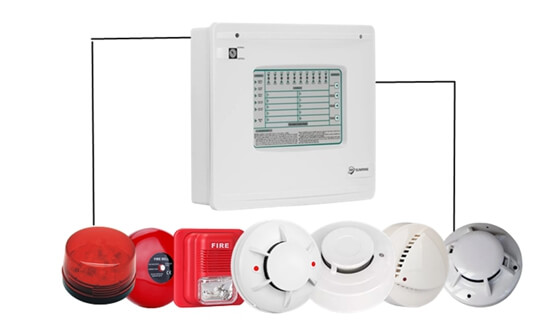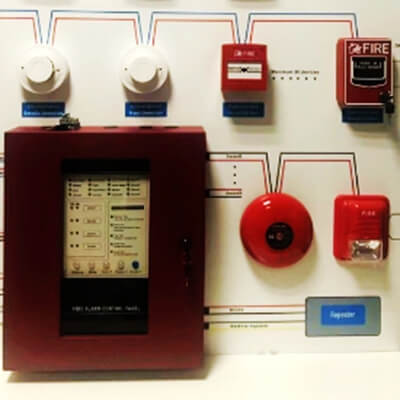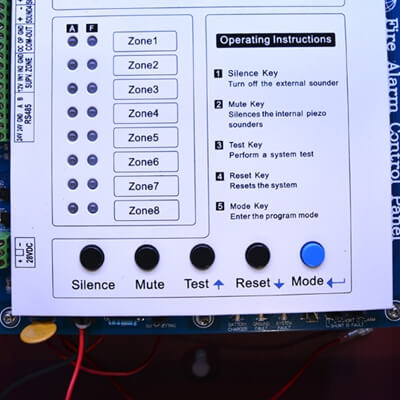What is a Fire Alarm Control Panel (FACP) and How Does It Work?
A Fire Alarm Control Panel (FACP) serves as the central command center of a fire safety system, linking all detection and alert devices. When sensors like smoke detectors or manual pull stations send an emergency signal, the FACP triggers alarms—such as sirens, strobes, or voice evacuation systems—to warn occupants of potential danger. Below, we break down its roles, types, and critical functions for safety and compliance.
Types of Fire Alarm Control Panels
-
Conventional FACPs
-
Organize devices into zones (e.g., "Floor 3, East Wing") for simplified monitoring.
-
Ideal for smaller buildings where pinpointing exact alarm sources is less critical.
-
-
Addressable FACPs
-
Assign unique identifiers to each device (e.g., “Device 57: Basement Electrical Room Smoke Detector”).
-
Perfect for large or complex facilities, enabling precise location tracking of alarms.
-
-
Hybrid Systems
-
Combine conventional zoning with addressable technology for flexibility in upgrades or expansions.
-

-
Key Features of a Modern Fire Alarm Control Panel (FACP)
-
Interactive Digital Display: Shows real-time system status (normal, alarm, trouble) and identifies triggered devices in addressable systems.
-
Functional Controls: Allows authorized staff to silence alarms, reset the system post-emergency, or run diagnostics.
-
Power Management: Runs on primary power with backup batteries to maintain operation during outages.
3 Critical Signals Processed by an FACP
-
Alarm Signal
-
Indicates potential fire detection (smoke, heat, manual activation).
-
Triggers evacuation alerts (horns, strobes) and notifies emergency services automatically.
-
-
Supervisory Signal
-
Flags issues impacting system readiness (e.g., valve closures, low water pressure in sprinklers).
-
Alerts staff for immediate action without activating evacuation alarms.
-
-
Trouble Signal
-
Warns of technical faults like wiring errors, communication failures, or battery problems.
-
Requires prompt troubleshooting to ensure system reliability.
-
Why FACPs Matter for Safety and Compliance
-
Rapid Response: Directs occupants to evacuate and ensures emergency crews are dispatched swiftly.
-
Detailed Diagnostics: Addressable systems provide exact device locations, speeding up incident resolution.
-
Code Compliance: Meets standards like NFPA 72, ensuring systems are inspection-ready.
Integration with Building Systems
Modern Fire Alarm Control Panels (FACP)s often connect to HVAC systems, fire doors, elevators, and suppression systems (sprinklers or gas-based solutions) to contain hazards. Advanced models also support remote monitoring via cloud platforms for real-time oversight.
By understanding the role of a Fire Alarm Control Panel (FACP), businesses and property managers can optimize safety protocols, minimize downtime, and protect lives and assets during emergencies. Whether upgrading an existing system or installing a new one, choosing the right Fire Alarm Control Panel (FACP) type is crucial for tailored fire protection.
-
 What is the control panel in a fire alarm system?
What is the control panel in a fire alarm system?Do you like ?0
Read more -
 What are the application objects of the fire safety panel ?
What are the application objects of the fire safety panel ?Do you like ?0
Read more -
 Why does the protector fire alarm panel need self inspection?
Why does the protector fire alarm panel need self inspection?Do you like ?0
Read more -
 Do you know the theoretical knowledge of conventional control panel ?
Do you know the theoretical knowledge of conventional control panel ?Do you like ?0
Read more -
 Why do you need a fire safety panel in your building ?
Why do you need a fire safety panel in your building ?Do you like ?0
Read more -
 what buttons of fire fighting control panel that need to push ?
what buttons of fire fighting control panel that need to push ?Do you like ?0
Read more








